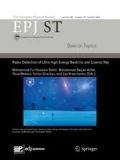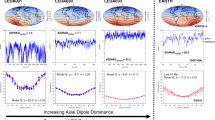Abstract
The geomagnetic field is generated by a dynamo process in the Earth’s core and is characterized by a predominant dipole component that has been steadily decreasing in the last few centuries. The physical drivers behind the fluctuations of the geomagnetic dipole field remain poorly understood. One of the possible explanations rely on the interaction between the dipole mode and other multipole terms of the geomagnetic field. To test this hypothesis, we used two millennial scale models based on spherical harmonic fitting of paleomagnetic data, which allowed to reconstruct the geomagnetic field of the past. By performing causality and information statistical analysis, we found significant interactions between the dipole and smaller scale harmonics (quadrupole and octupole) of the geomagnetic field. In particular, both data sets agree that the spherical harmonic \(Y_2^2\) acts as a source term, whereas the axial dipole term \(Y_1^0\) consists of the term with least information loss. The results suggest a possible control of core–mantle boundary inhomogeneities on the interaction between the components of the geomagnetic field. Our results also show a net information flux from larger to smaller scales, which is compatible with a direct turbulent cascade view of the geodynamo.





Similar content being viewed by others
References
R.T. Merrill, M.W. McElhinny, P.L. McFadden, The Magnetic Field of the Earth: Paleomagnetism, the Core, and the Deep Mantle (Academic, San Diego, 1996)
M. Kono, in: Treatise on Geophysics, vol. 5, ed. M. Kono. (Elsevier Science, 2007), pp. 1–32
F. Terra-Nova, H. Amit, G. Choblet, Preferred locations of weak surface field in numerical dynamos with heterogeneous core mantle boundary heat flux: consequences for the South Atlantic Anomaly. Geophys. J. Int. 217(2), 1179–1199 (2019)
M. Lockwood, Solar influence on global and regional climates. Surv. Geophys. 33(3), 503–534 (2012)
W. Poletti, A.J. Biggin, R.I. Trindade, G.A. Hartmann, F. Terra-Nova, Continuous millennial decrease of the Earth’s magnetic axial dipole. Phys. Earth Planet. Inter. 274, 72–86 (2018)
R.I. Trindade, P. Jaqueto, F. Terra-Nova, D. Brandt, G.A. Hartmann, J.M. Feinberg, H. Cheng, Speleothem record of geomagnetic South Atlantic Anomaly recurrence. Proc. Natl. Acad. Sci. 115(52), 13198–13203 (2018)
F.J. Pavon-Carrasco, A. De Santis, The South Atlantic Anomaly: the key for a possible geomagnetic reversal. Front. Earth Sci. 4, 40 (2016)
M. Brown, M. Korte, R. Holme, I. Wardinski, S. Gunnarson, Earth’s magnetic field is probably not reversing. Proc. Natl. Acad. Sci. 115(20), 5111–5116 (2018)
B. Buffett, W. Davis, A probabilistic assessment of the next geomagnetic reversal. Geophys. Res. Lett. 45(4), 1845–1850 (2018)
P.H. Roberts, G.A. Glatzmaier, Geodynamo theory and simulations Rev. Mod. Phys. 72, 1081–1124 (2000)
J. Aubert, H. Amit, G. Hulot, P. Olson, Thermochemical flows couple the Earth’s inner core growth to mantle heterogeneity. Nature 454(7205), 758–761 (2008)
P. Olson, U.R. Christensen, The time-averaged magnetic field in numerical dynamos with non-uniform boundary heat flow. Geophys. J. Int. 151(3), 809–823 (2002)
B. Raphaldini, C.F.M. Raupp, Nonlinear MHD Rossby wave interactions and persistent geomagnetic field structures. Proc. R. Soc. A 47620200174 (2020)
D. Gubbins, A.P. Willis, B. Sreenivasan, Correlation of Earth’s magnetic field with lower mantle thermal and seismic structure. Phys. Earth Planet. Inter. 162(3–4), 256–260 (2007)
J. Mound, C. Davies, S. Rost, J. Aurnou, Regional stratification at the top of Earth’s core due to core-mantle boundary heat flux variations. Nat. Geosci. 12(7), 575–580 (2019)
P. Olson, M. Landeau, E. Reynolds, Dynamo tests for stratification below the core-mantle boundary. Phys. Earth Planet. Inter. 271, 1–18 (2017)
L.A. Baccalá, K. Sameshima, Partial directed coherence: a new concept in neural structure determination. Biol. Cybern. 84, 463–474 (2001)
C. Constable, M. Korte, S. Panovska, Persistent high paleosecular variation activity in southern hemisphere for at least 10,000 years. Earth Planet. Sci. Lett. 453, 78–86 (2016)
M. Korte, M. Brown, S. Gunnarson, LSMOD.1—global paleomagnetic field model for 50–30 ka BP. https://doi.org/10.5880/GFZ.2.3.2018.008 (2018)
H. Amit, P. Olson, A dynamo cascade interpretation of the geomagnetic dipole decrease. Geophys. J. Int 181(3), 1411–1427 (2010)
F. Lhuillier, A. Fournier, G. Hulot, J. Aubert, The geomagnetic secular-variation timescale in observations and numerical dynamo models. Geophys. Res. Lett. 38(9), 1–5 (2011)
H. Amit, M. Coutelier, U.R. Christensen, On equatorially symmetric and antisymmetric geomagnetic secular variation timescales. Phys. Earth Planet. Inter. 276, 190–201 (2018)
C. Bouligand, N. Gillet, D. Jault, N. Schaeffer, A. Fournier, J. Aubert, Frequency spectrum of the geomagnetic field harmonic coefficients from dynamo simulations. Geophys. Suppl. Mon. Not. R. Astron. Soc. 207(2), 1142–1157 (2016)
U.R. Christensen, A. Tilgner, Power requirement of the geodynamo from ohmic losses in numerical and laboratory dynamos. Nature 429(6988), 169–171 (2004)
P. Mininni, A. Alexakis, A. Pouquet, Shell-to-shell energy transfer in magnetohydrodynamics. II. Kinematic dynamo. Phys. Rev. E 72(4), 046302 (2005)
A. Alexakis, P.D. Mininni, A. Pouquet, Shell-to-shell energy transfer in magnetohydrodynamics. I. Steady state turbulence. Phys. Rev. E 72(4), 046301 (2005)
M.G. Kivelson, M.G. Kivelson, C.T. Russell (eds.) Introduction to Space Physics (Cambridge University Press, 1995)
C.W.J. Granger, Investigating causal relations by econometric models and cross-spectral methods. Econometrica 37, 424–438 (1969)
D.Y. Takahashi, L.A. Baccalá, K. Sameshima, Information theoretic interpretation of frequency domain connectivity measures. Biol. Cybern. 103(6), 463–469 (2010)
D.Y. Takahashi, L.A. Baccalá, K. Sameshima, Connectivity inference between neural structures via partial directed coherence. J. Appl. Stat. 10(1259–1273), 648–650 (2007)
K. Dzirasa, A.J. Ramsey, D.Y. Takahashi, J. Stapleton, J.M. Potes, J.K. Williams, R.R. Gainetdinov, K. Sameshima, M.G. Caron, M.A.L. Nicolelis, Hyperdopaminergia and NMDA receptor hypofunction disrupt neural phase signaling. J. Neurosci. 29, 8215–8224 (2000)
A. Allali, A. Oueslati, A. Trabelsi, Detection of information flow in major international financial markets by interactivity network analysis. Asia Pac. Finan. Markets 18, 319–344 (2010)
K. Henschel, B. Hellwig, F. Amtage, J. Vesper, M. Jachan, C.H. Lücking, B. Timmer, J. Schelter, Multivariate analysis of dynamical processes point processes and time series. Eur. Phys. J. 165(1), 25–34 (2010)
M. Winterhalder, B. Schelter, J. Timmer, Detecting coupling directions in multivariate oscillatory systems. Int. J. Bifurc. Chaos 17(10), 3735–3739 (2007). https://doi.org/10.1142/S0218127407019664
J.R. Sato, D.Y. Takahashi, S.M. Arcuri, K. Sameshima, P.A. Morettin, L.A. Baccalá, Frequency domain connectivity identification: an application of partial directed coherence in fMRI. Hum. Brain Mapp. 30, 452–461. https://doi.org/10.1002/hbm.20513 (2009)
B. Raphaldini, A.S. Teruya, L. da Silva, P. Dias, L. Massaroppe, D.Y. Takahashi, Stratospheric ozone and quasi-biennial oscillation (QBO) interaction with the tropical troposphere on intraseasonal and interannual timescales: a normal-mode perspective. Earth Syst. Dyn. 12(1), 83–101 (2021)
C.E. Shannon, A mathematical theory of communication. Bell Syst. Tech. J. 27(3), 379–423 (1948)
T.M. Cover, Elements of information theory (Wiley, New York, 1999)
I.M. Gelfand, A.M. Yaglom, Calculation of the amount of information about a random function contained in another such function. Am. Math. Soc. Transl. 2(12), 191–198 (1959)
C.G. Antonopoulos, E. Bianco-Martinez, M.S. Baptista, Production and transfer of energy and information in Hamiltonian systems. PloS One 9(2), e89585 (2014)
B. Raphaldini, D.Y. Takahashi, A.S.W. Teruya, C.F.M. Raupp, P.L. Silva-Dias, Information flow between MJO-related waves: a network approach on the wave space. Phys. J. Spec. Top. Eur. (2021). https://doi.org/10.1140/epjs/s11734-021-00170-5
B. Raphaldini, E.S. Medeiros, D. Ciro, D.R. Franco, R.I. Trindade, Geomagnetic reversals at the edge of regularity. Phys. Rev. Res. 3(1), 013158 (2021)
S.L. Marple Jr., Digital Spectral Analysis (Prentice Hall, New Jersey, 1987)
A. Schlogl, A comparison of multivariate autoregressive estimators. Signal Process. 86, 2426–2429 (2006)
H. Lütkepohl, New Introduction to Multiple Time Series Analysis (Springer, Berlin, 2005)
L. Huguet, H. Amit, Magnetic energy transfer at the top of Earth’s core. Geophys. J. Int. 190, 856–870 (2012)
G. Masters, G. Laske, H. Bolton, A. Dziewonski, The relative behavior of shear velocity, bulk sound speed, and compressional velocity in the mantle: implications for chemical and thermal structure. Earth’s Deep Inter. Miner. Phys. Tomogr. At. Glob. Scale 117, 63–87 (2000)
U.R. Christensen, Geodynamo models with a stable layer and heterogeneous heat flow at the top of the core. Geophys. J. Int. 215(2), 1338–1351 (2018)
C. Laj, A. Mazaud, R. Weeks, M. Fuller, E. Herrero Bervera, Statistical assessment of the preferred longitudinal bands for recent geomagnetic reversal records. Geophys. Res. Lett. 19(20), 2003–2006 (1992)
M. Korte, R. Holme, On the persistence of geomagnetic flux lobes in global Holocene field models. Phys. Earth Planet. Inter. 182(3–4), 179–186 (2010)
U. Frisch, Turbulence: the Legacy of A.N. Kolmogorov (Cambridge University Press, Cambridge, 1995)
D. Biskamp, Magnetohydrodynamic turbulence (Cambridge University Press, Cambridge, 2003)
A. Pouquet, U. Frisch, J. Lèorat, Strong MHD helical turbulence and the non-linear dynamo effect. J. Fluid Mech. 77, 321–354 (1976)
P. Olson, U.R. Christensen, G.A. Glatzmaier, Numerical modeling of the geodynamo: mechanisms of field generation and equilibration. J. Geophys. Res. 104, 10383–10404 (1999)
F. Plunian, R. Stepanov, Cascades and dissipation ratio in rotating MHD turbulence at low magnetic Prandtl number. Phys. Rev E. 82, 046311 (2010)
M. Reshetnyak, P. Hejda, Direct and inverse cascades in the geodynamo. Nonlinear Processes Geophys. 15, 873–880 (2008)
J.-P. Valet, L. Meynadier, Geomagnetic field intensity and reversals during the past four million years. Nature 366, 234–238 (1993)
D.A. Ryan, G.R. Sarson, Are geomagnetic field reversals controlled by turbulence within the Earth’s core? Geophys. Res. Lett. 34, L02307 (2007)
P.W. Livermore, A. Fournier, Y. Gallet, Core-flow constraints on extreme archeomagnetic intensity changes. Earth Planet. Sci. Lett. 387, 145–156 (2014)
Acknowledgements
We thank Drs. Ricardo Ivan Ferreira Trindade and Felipe Terra-Nova for their suggestions, as well as Dr. Koichi Sameshima and Luiz Baccala for providing their program to evaluate PDC. We thank Hagay Amit and one anonymous reviewer for the careful revision of the manuscript. This work was financially supported by Fundação de Amparo à Pesquisa do Estado de São Paulo (FAPESP) through grants 2015/50122-0, 2015/50686-1 and 2017/23417-5, and by Coordenação de Aperfeiçoamento de Pessoal de Nível Superior-Brasil (CAPES)-Finance Code 001.
Author information
Authors and Affiliations
Corresponding author
Rights and permissions
About this article
Cite this article
Raphaldini, B., Teruya, A.S.W., Raupp, C.F.M. et al. Inference of the topology of geomagnetic field multipole interactions. Eur. Phys. J. Spec. Top. 230, 2999–3007 (2021). https://doi.org/10.1140/epjs/s11734-021-00201-1
Received:
Accepted:
Published:
Issue Date:
DOI: https://doi.org/10.1140/epjs/s11734-021-00201-1



